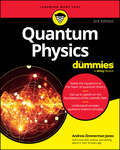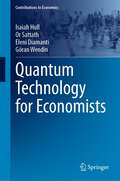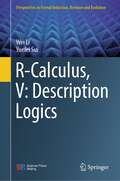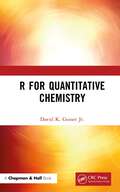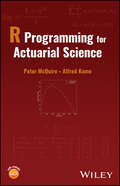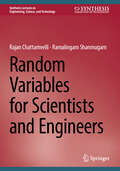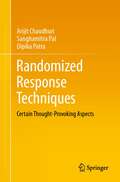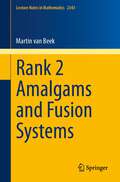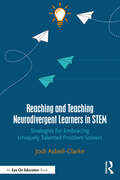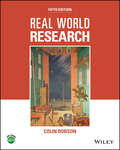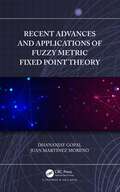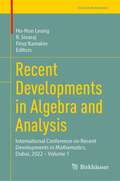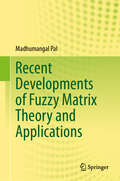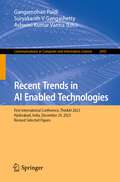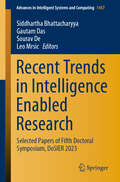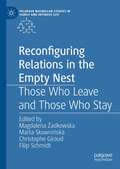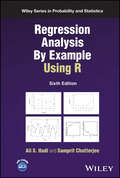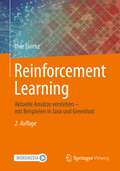- Table View
- List View
Quantum Physics For Dummies
by Andrew Zimmerman JonesThe plain-English guide to understanding quantum physics Mastering quantum physics is no easy feat, but with the help of Quantum Physics For Dummies you can work at your own pace to unlock key concepts and fascinating facts. Packed with invaluable explanations, equations, and step-by-step instructions, this book makes a challenging subject much more accessible. Great for college students taking a quantum physics course, Quantum Physics For Dummies offers complete coverage of the subject, along with numerous examples to help you tackle the tough stuff. The Schrodinger Equation, the foundations of quantum physics, vector notation, scattering theory, angular momentum—it’s all in here. This handy guide helps you prepare for exams and succeed at learning quantum physics. Get clear explanations of the core concepts in quantum physics Review the math principles needed for quantum physics equations Learn the latest breakthroughs and research in the field Clarify difficult subjects and equations from your college courseQuantum Physics For Dummies is great a resource for students who need a supplement to the textbook to help them tackle this challenging subject.
Quantum Physics For Dummies
by Andrew Zimmerman JonesThe plain-English guide to understanding quantum physics Mastering quantum physics is no easy feat, but with the help of Quantum Physics For Dummies you can work at your own pace to unlock key concepts and fascinating facts. Packed with invaluable explanations, equations, and step-by-step instructions, this book makes a challenging subject much more accessible. Great for college students taking a quantum physics course, Quantum Physics For Dummies offers complete coverage of the subject, along with numerous examples to help you tackle the tough stuff. The Schrodinger Equation, the foundations of quantum physics, vector notation, scattering theory, angular momentum—it’s all in here. This handy guide helps you prepare for exams and succeed at learning quantum physics. Get clear explanations of the core concepts in quantum physics Review the math principles needed for quantum physics equations Learn the latest breakthroughs and research in the field Clarify difficult subjects and equations from your college courseQuantum Physics For Dummies is great a resource for students who need a supplement to the textbook to help them tackle this challenging subject.
Quantum Technology for Economists (Contributions to Economics)
by Isaiah Hull Or Sattath Eleni Diamanti Göran WendinThis book offers an introduction to quantum technology that is specifically tailored to economists, students of economics, and professionals in the financial and payments industries. The book reviews quantum speedups that have been identified for algorithms used to solve and estimate economic models, including function approximation, linear systems analysis, graphical modeling, Monte Carlo simulation, matrix inversion, principal component analysis, linear regression, dynamic programming, interpolation, numerical differentiation, and true random number generation. It also provides an overview of quantum financial technology and its potential applications in economics and finance. Written by an interdisciplinary team with backgrounds in economics, computer science, and physics, this book offers a valuable guide for researchers and practitioners who want to understand the implications and possibilities of quantum technology for the field of economics.
R-Calculus, V: Description Logics (Perspectives in Formal Induction, Revision and Evolution)
by Wei Li Yuefei SuiThis book series consists of two parts, decidable description logics and undecidable description logics. It gives the R-calculi for description logics. This book offers a rich blend of theory and practice. It is suitable for students, researchers and practitioners in the field of logic.
R for Quantitative Chemistry
by David K. GosserR for Quantitative Chemistry is an exploration of how the R language can be applied to a wide variety of problems in what is typically termed "Quantitative Chemistry" or sometimes "Analytical Chemistry". Topics include: basic statistics, spectroscopic data, acid base equilibria and titrations, binding curves (of great current interest for biomedical applications), Fourier Transforms, and chemical kinetics and enzyme kinetics. An innovative feature is the discussion (as an alternative to the less stable nls packages) of the simplex adaptation subplex (R package) coupled with Monte Carlo analysis to determine confidence intervals for estimated parameters resulting from least squares optimization. Chemists who are interested in learning R as a research tool as well as Chemists who are teaching Quantitative Chemistry, as well as their students will be interested. This book is useful as most R books approach data analysis from an economic, social, medical, or biological context. Analysis of chemical data draws upon specific numerical models and a different set R programming and packages than is typically discussed in other disciplines. This book will be based upon, in large part, actual experimental data and will include end of chapter questions and projects. Readers are encouraged to email the author at gosserch@gmail.com and to follow the accompanying blog on Medium "R Programming for Quantitative Chemistry". Key Features: Elements of R programming for Chemists Literature Based Examples Includes Binding Assay Analysis Integrates theory, experiment, and R programming
R for Quantitative Chemistry
by David K. GosserR for Quantitative Chemistry is an exploration of how the R language can be applied to a wide variety of problems in what is typically termed "Quantitative Chemistry" or sometimes "Analytical Chemistry". Topics include: basic statistics, spectroscopic data, acid base equilibria and titrations, binding curves (of great current interest for biomedical applications), Fourier Transforms, and chemical kinetics and enzyme kinetics. An innovative feature is the discussion (as an alternative to the less stable nls packages) of the simplex adaptation subplex (R package) coupled with Monte Carlo analysis to determine confidence intervals for estimated parameters resulting from least squares optimization. Chemists who are interested in learning R as a research tool as well as Chemists who are teaching Quantitative Chemistry, as well as their students will be interested. This book is useful as most R books approach data analysis from an economic, social, medical, or biological context. Analysis of chemical data draws upon specific numerical models and a different set R programming and packages than is typically discussed in other disciplines. This book will be based upon, in large part, actual experimental data and will include end of chapter questions and projects. Readers are encouraged to email the author at gosserch@gmail.com and to follow the accompanying blog on Medium "R Programming for Quantitative Chemistry". Key Features: Elements of R programming for Chemists Literature Based Examples Includes Binding Assay Analysis Integrates theory, experiment, and R programming
R Programming for Actuarial Science
by Peter McQuire Alfred KumeR Programming for Actuarial Science Professional resource providing an introduction to R coding for actuarial and financial mathematics applications, with real-life examples R Programming for Actuarial Science provides a grounding in R programming applied to the mathematical and statistical methods that are of relevance for actuarial work. In R Programming for Actuarial Science, readers will find: Basic theory for each chapter to complement other actuarial textbooks which provide foundational theory in depth. Topics covered include compound interest, statistical inference, asset-liability matching, time series, loss distributions, contingencies, mortality models, and option pricing plus many more typically covered in university courses. More than 400 coding examples and exercises, most with solutions, to enable students to gain a better understanding of underlying mathematical and statistical principles. An overall basic to intermediate level of coverage in respect of numerous actuarial applications, and real-life examples included with every topic. Providing a highly useful combination of practical discussion and basic theory, R Programming for Actuarial Science is an essential reference for BSc/MSc students in actuarial science, trainee actuaries studying privately, and qualified actuaries with little programming experience, along with undergraduate students studying finance, business, and economics.
R Programming for Actuarial Science
by Peter McQuire Alfred KumeR Programming for Actuarial Science Professional resource providing an introduction to R coding for actuarial and financial mathematics applications, with real-life examples R Programming for Actuarial Science provides a grounding in R programming applied to the mathematical and statistical methods that are of relevance for actuarial work. In R Programming for Actuarial Science, readers will find: Basic theory for each chapter to complement other actuarial textbooks which provide foundational theory in depth. Topics covered include compound interest, statistical inference, asset-liability matching, time series, loss distributions, contingencies, mortality models, and option pricing plus many more typically covered in university courses. More than 400 coding examples and exercises, most with solutions, to enable students to gain a better understanding of underlying mathematical and statistical principles. An overall basic to intermediate level of coverage in respect of numerous actuarial applications, and real-life examples included with every topic. Providing a highly useful combination of practical discussion and basic theory, R Programming for Actuarial Science is an essential reference for BSc/MSc students in actuarial science, trainee actuaries studying privately, and qualified actuaries with little programming experience, along with undergraduate students studying finance, business, and economics.
Random Variables for Scientists and Engineers (Synthesis Lectures on Engineering, Science, and Technology)
by Ramalingam Shanmugam Rajan ChattamvelliThis book provides an introductory overview of random variables and their transformations. The authors approach the topic with statistics students in mind, along with researchers in various fields who are interested in data analysis. The book begins with by defining and explaining mathematical expectation. The authors then discuss transformations of random variables, including distribution functions and special functions. The book also covers joint probability distribution and its applications. The authors have updated and expanded upon their writing on these topics, which they originally covered in their previous book, Statistics for Scientists and Engineers.
Randomized Response Techniques: Certain Thought-Provoking Aspects
by Arijit Chaudhuri Sanghamitra Pal Dipika PatraThis book presents an up-to-date perspective on randomized response techniques (RRT). It discusses the most appropriate and efficient procedures of RRT for analysing data from queries dealing with sensitive and confidential issues, including the treatment of infinite and finite population setups. The book aims to spark a renewed interest among sampling experts who may have overlooked RRT. By addressing the missing topics and incorporating a wide range of contributors' works, it seeks to foster an appreciative academic environment and inspire a reformed and amended view of RRT. As the book unfolds, readers will gain valuable insights into the evolving landscape of RRT and its applications, positioning them at the forefront of this engaging field of study.On RRT, the literature has grown immensely since its inception in 1965 by S.L. Warner. Despite several books published on the subject, there are still two crucial topics missing from the existing RRT literature. This book aimsto address these gaps and provide valuable insights to curious readers in the field. The book is mandatory reading for statisticians and biostatisticians, market researchers, operations researchers, pollsters, sociologists, political scientists, economists and advanced undergraduate and graduate students in these areas.
Rank 2 Amalgams and Fusion Systems (Lecture Notes in Mathematics #2343)
by Martin van BeekThis monograph provides a comprehensive treatment of the classification of small fusion systems, that is, fusion systems with few essential subgroups. It demonstrates a broad range of techniques from local group theory and fusion systems, several of which can be applied in more general settings. Addressing research problems that have not been treated in the past, it is the first text to explicitly use the amalgam method in this context. Fusion systems offer an enticing way to unify various p-local methods employed in group theory, representation theory and homotopy theory; but as abstract constructions they are still somewhat mysterious. This book paves the way to a broad and systematic study of these categories by applying the amalgam method, thus modernizing a methodology widely used to understand the local structure of finite groups. With this comes an introduction to several vital techniques in local group theory, a generous survey of the structure and modular representation theory of some important families of finite groups, and a demonstration of the value of combinatorial methods in finite group theory and fusion systems. Primarily aimed at researchers active in fusion systems and group amalgams, the book will also be of interest to anyone working with finite groups and their modular representations, group actions on trees, or classifying spaces. The inclusion of preliminary chapters outlining the theoretical prerequisites make it ideal for a short lecture course or as a reading group text for early career researchers and graduate students.
Reaching and Teaching Neurodivergent Learners in STEM: Strategies for Embracing Uniquely Talented Problem Solvers
by Jodi Asbell-ClarkeProviding salient stories and practical strategies, this book empowers educators to embrace the unique talents of neurodivergent learners in science, technology, engineering, and mathematics (STEM). An exploration of the exciting opportunities neurodiversity presents to build an innovative workforce is grounded in a large body of research from psychology, neuroscience, and education. Author Jodi Asbell-Clarke presents individual examples of neurodivergent journeys in STEM to establish evidence-based connections between neurodiversity and the types of innovative problem-solving skills needed in today’s workforce. The featured stories come directly from the author’s many years in inclusive classrooms with STEM teachers along with interviews from many neurodivergent professionals in STEM. Teachers will learn how to embrace the unique brilliance and potential of the neurodivergent learners in their classroom, working against historic marginalization and deficit-based perspectives of neurodiversity within the education system. Featuring illustrations of classroom-designed tools and materials alongside basic strategies to support executive function and emotion in learning, this book will help you nurture the talents of your neurodivergent learners and recognize their unique potential within STEM. Ideal for K-12 classroom teachers, special educators, learning specialists, psychologists, and school administrators.
Reaching and Teaching Neurodivergent Learners in STEM: Strategies for Embracing Uniquely Talented Problem Solvers
by Jodi Asbell-ClarkeProviding salient stories and practical strategies, this book empowers educators to embrace the unique talents of neurodivergent learners in science, technology, engineering, and mathematics (STEM). An exploration of the exciting opportunities neurodiversity presents to build an innovative workforce is grounded in a large body of research from psychology, neuroscience, and education. Author Jodi Asbell-Clarke presents individual examples of neurodivergent journeys in STEM to establish evidence-based connections between neurodiversity and the types of innovative problem-solving skills needed in today’s workforce. The featured stories come directly from the author’s many years in inclusive classrooms with STEM teachers along with interviews from many neurodivergent professionals in STEM. Teachers will learn how to embrace the unique brilliance and potential of the neurodivergent learners in their classroom, working against historic marginalization and deficit-based perspectives of neurodiversity within the education system. Featuring illustrations of classroom-designed tools and materials alongside basic strategies to support executive function and emotion in learning, this book will help you nurture the talents of your neurodivergent learners and recognize their unique potential within STEM. Ideal for K-12 classroom teachers, special educators, learning specialists, psychologists, and school administrators.
Real World Research
by Colin RobsonREAL WORLD RESEARCH Provides students and practitioner alike with clear and systematic guidance on performing social research in applied settings Real World Research supplies the multidisciplinary skills necessary to conduct social research projects inside and outside of the classroom or the workplace. Offering well-balanced coverage of qualitative, quantitative, and mixed methods, this highly practical resource incorporates approaches from different social science disciplines to help readers find answers to real-life research questions in healthcare, education, business and management, and in many other public and private settings. Detailed yet accessible chapters include step-by-step advice for developing a research question, choosing a research design strategy, collecting and analyzing the data, interpreting and reporting the results, and more. The fifth edition contains timely coverage of contemporary methodologies, key ethical issues, and ongoing debates within the field of social research. New and expanded sections address topics such as evidence‐based approaches to social research, ethical considerations when conducting research involving people, carrying out projects based solely on existing research, and the importance and implications of internet-based research. Featuring a wealth of up-to-date examples drawn from a wide range of disciplines, this classic textbook: Focuses on useful real-world research in applied settings such as homes, schools, businesses, and other workplaces Provides a concise overview and a well-defined example of each main step of the research process Highlights the importance of collaboration, cooperation, and active participation in social research Explains flexible research designs using largely qualitative methods, including additional coverage of ethnographic and grounded theory approaches Includes an extensive companion website with numerous research examples, links to journal articles, PowerPoint slides, and many other additional resources Real World Research, Fifth Edition, remains essential reading for those tasked with developing, performing, and reporting the findings of a research project, including students, academics and educators, social scientists, health practitioners, and professionals in a diverse range of fields.
Real World Research
by Colin RobsonREAL WORLD RESEARCH Provides students and practitioner alike with clear and systematic guidance on performing social research in applied settings Real World Research supplies the multidisciplinary skills necessary to conduct social research projects inside and outside of the classroom or the workplace. Offering well-balanced coverage of qualitative, quantitative, and mixed methods, this highly practical resource incorporates approaches from different social science disciplines to help readers find answers to real-life research questions in healthcare, education, business and management, and in many other public and private settings. Detailed yet accessible chapters include step-by-step advice for developing a research question, choosing a research design strategy, collecting and analyzing the data, interpreting and reporting the results, and more. The fifth edition contains timely coverage of contemporary methodologies, key ethical issues, and ongoing debates within the field of social research. New and expanded sections address topics such as evidence‐based approaches to social research, ethical considerations when conducting research involving people, carrying out projects based solely on existing research, and the importance and implications of internet-based research. Featuring a wealth of up-to-date examples drawn from a wide range of disciplines, this classic textbook: Focuses on useful real-world research in applied settings such as homes, schools, businesses, and other workplaces Provides a concise overview and a well-defined example of each main step of the research process Highlights the importance of collaboration, cooperation, and active participation in social research Explains flexible research designs using largely qualitative methods, including additional coverage of ethnographic and grounded theory approaches Includes an extensive companion website with numerous research examples, links to journal articles, PowerPoint slides, and many other additional resources Real World Research, Fifth Edition, remains essential reading for those tasked with developing, performing, and reporting the findings of a research project, including students, academics and educators, social scientists, health practitioners, and professionals in a diverse range of fields.
Recent Advances and Applications of Fuzzy Metric Fixed Point Theory
by Dhananjay Gopal Juan Martinez MorenoThis book not only presents essential material to understand fuzzy metric fixed point theory, but also enables the readers to appreciate the recent advancements made in this direction. It contains seven chapters on different topics in fuzzy metric fixed point theory. These chapters cover a good range of interesting topics such as con- vergence problems in fuzzy metrics, fixed figure problems, and applications of fuzzy metrics. The main focus is to unpack a number of diverse aspects of fuzzy metric fixed point theory and its applications in an understandable way so that it could help and motivate young graduates to explore new avenues of research to extend this flourishing area in different directions. The discussion on fixed figure problems and fuzzy contractive fixed point theorems and their different generalizations invites active researchers in this field to develop a new branch of fixed point theory. Features: Explore the latest research and developments in fuzzy metric fixed point theory. Describes applications of fuzzy metrics to colour image processing. Covers new topics on fuzzy fixed figure problems. Filled with examples and open problems. This book serves as a reference book for scientific investigators who want to analyze a simple and direct presentation of the fundamentals of the theory of fuzzy metric fixed point and its applications. It may also be used as a textbook for postgraduate and research students who try to derive future research scope in this area.
Recent Advances and Applications of Fuzzy Metric Fixed Point Theory
by Dhananjay Gopal Juan Martinez MorenoThis book not only presents essential material to understand fuzzy metric fixed point theory, but also enables the readers to appreciate the recent advancements made in this direction. It contains seven chapters on different topics in fuzzy metric fixed point theory. These chapters cover a good range of interesting topics such as con- vergence problems in fuzzy metrics, fixed figure problems, and applications of fuzzy metrics. The main focus is to unpack a number of diverse aspects of fuzzy metric fixed point theory and its applications in an understandable way so that it could help and motivate young graduates to explore new avenues of research to extend this flourishing area in different directions. The discussion on fixed figure problems and fuzzy contractive fixed point theorems and their different generalizations invites active researchers in this field to develop a new branch of fixed point theory. Features: Explore the latest research and developments in fuzzy metric fixed point theory. Describes applications of fuzzy metrics to colour image processing. Covers new topics on fuzzy fixed figure problems. Filled with examples and open problems. This book serves as a reference book for scientific investigators who want to analyze a simple and direct presentation of the fundamentals of the theory of fuzzy metric fixed point and its applications. It may also be used as a textbook for postgraduate and research students who try to derive future research scope in this area.
Recent Developments in Algebra and Analysis: International Conference on Recent Developments in Mathematics, Dubai, 2022 – Volume 1 (Trends in Mathematics)
by Ho-Hon Leung R. Sivaraj Firuz KamalovThis volume collects the proceedings of the International Conference on Recent Developments in Mathematics (ICRDM), held at Canadian University Dubai, UAE, in August 2022. It is the first of two volumes, this first volume focuses on recent advances in algebra and analysis, and the second volume covers more applied topics. Each chapter identifies existing challenges in these theoretical areas, and highlights the importance of establishing new theorems and algorithms to address them. Recent Developments in Algebra and Analysis will appeal to a range of postgraduate students and researchers who are interested in exploring more on these areas and play an integral role in modern science.
Recent Developments of Fuzzy Matrix Theory and Applications
by Madhumangal PalThis book provides a comprehensive overview of the development of fuzzy matrix theory from its inception to its current state. It covers various types of fuzzy matrices, such as intuitionistic fuzzy matrices, interval-valued fuzzy matrices, interval-valued intuitionistic fuzzy matrices, bipolar fuzzy matrices, picture fuzzy matrices, neutrosophic fuzzy matrices, m-polar fuzzy matrices and similar one. Drawing primarily from the author's research work and collaborations, the book offers a state-of-the-art discussion of these topics. Theoretical concepts are illustrated with examples for clarity, accompanied by figures depicting fuzzy matrices and their variations. Suitable for both beginners and expert researchers, the book offers a wealth of material and includes numerous open problems at the end of almost all chapters to encourage further exploration and investigation.
Recent Trends in AI Enabled Technologies: First International Conference, ThinkAI 2023, Hyderabad, India, December 29, 2023, Revised Selected Papers (Communications in Computer and Information Science #2045)
by Gangamohan Paidi Suryakanth V Gangashetty Ashwini Kumar VarmaThis book constitutes the refereed proceedings of the First International Conference on Recent Trends in AI Enabled Technologies, ThinkAI 2023, which took place in Hyderabad, India, in December 2023. The 7 full papers presented in these proceedings were carefully reviewed and selected from 51 submissions. The conference focuses on on up to date topics and recent trends in artificial intelligence and related technologies.
Recent Trends in Intelligence Enabled Research: Selected Papers of Fifth Doctoral Symposium, DoSIER 2023 (Advances in Intelligent Systems and Computing #1457)
by Siddhartha Bhattacharyya Gautam Das Sourav De Leo MrsicThis book gathers extended versions of papers presented at DoSIER 2023 (Fifth Doctoral Symposium on Intelligence Enabled Research, held at Cooch Behar Government Engineering College, West Bengal, India, during December 20–21, 2023). The papers address the rapidly expanding research area of computational intelligence, which, no longer limited to specific computational fields, has since made inroads in signal processing, smart manufacturing, predictive control, robot navigation, smart cities, and sensor design, to name but a few. Presenting chapters written by experts active in these areas, the book offers a valuable reference guide for researchers and industrial practitioners alike and inspires future studies.
Reconfiguring Relations in the Empty Nest: Those Who Leave and Those Who Stay (Palgrave Macmillan Studies in Family and Intimate Life)
by Magdalena Żadkowska Marta Skowrońska Christophe Giraud Filip SchmidtThis edited volume traverses the spectrum of experiences that take place after children leave the family home and parents find themselves in the "empty nest" stage of life. Rather than focusing on measuring the intensity of empty nest syndrome or asking whether parents' marital satisfaction increases or decreases in this phase, the authors present rich qualitative data from across Poland and France to show that there is great variation in how families experience the empty nest, developing both a study on intimacy and love and on family solidarity. Throughout the book, themes of mixed emotions, nuanced attitudes, contradictions, and dissonance are explored while shedding light on "supporting actors" of the empty nest transition, such as family pets and material objects.
Regression Analysis By Example Using R (Wiley Series in Probability and Statistics)
by Ali S. Hadi Samprit ChatterjeeRegression Analysis By Example Using R A STRAIGHTFORWARD AND CONCISE DISCUSSION OF THE ESSENTIALS OF REGRESSION ANALYSIS In the newly revised sixth edition of Regression Analysis By Example Using R, distinguished statistician Dr Ali S. Hadi delivers an expanded and thoroughly updated discussion of exploratory data analysis using regression analysis in R. The book provides in-depth treatments of regression diagnostics, transformation, multicollinearity, logistic regression, and robust regression. The author clearly demonstrates effective methods of regression analysis with examples that contain the types of data irregularities commonly encountered in the real world. This newest edition also offers a brand-new, easy to read chapter on the freely available statistical software package R. Readers will also find: Reorganized, expanded, and upgraded exercises at the end of each chapter with an emphasis on data analysis Updated data sets and examples throughout the book Complimentary access to a companion website that provides data sets in xlsx, csv, and txt format Perfect for upper-level undergraduate or beginning graduate students in statistics, mathematics, biostatistics, and computer science programs, Regression Analysis By Example Using R will also benefit readers who need a reference for quick updates on regression methods and applications.
Regression Analysis By Example Using R (Wiley Series in Probability and Statistics)
by Ali S. Hadi Samprit ChatterjeeRegression Analysis By Example Using R A STRAIGHTFORWARD AND CONCISE DISCUSSION OF THE ESSENTIALS OF REGRESSION ANALYSIS In the newly revised sixth edition of Regression Analysis By Example Using R, distinguished statistician Dr Ali S. Hadi delivers an expanded and thoroughly updated discussion of exploratory data analysis using regression analysis in R. The book provides in-depth treatments of regression diagnostics, transformation, multicollinearity, logistic regression, and robust regression. The author clearly demonstrates effective methods of regression analysis with examples that contain the types of data irregularities commonly encountered in the real world. This newest edition also offers a brand-new, easy to read chapter on the freely available statistical software package R. Readers will also find: Reorganized, expanded, and upgraded exercises at the end of each chapter with an emphasis on data analysis Updated data sets and examples throughout the book Complimentary access to a companion website that provides data sets in xlsx, csv, and txt format Perfect for upper-level undergraduate or beginning graduate students in statistics, mathematics, biostatistics, and computer science programs, Regression Analysis By Example Using R will also benefit readers who need a reference for quick updates on regression methods and applications.
Reinforcement Learning: Aktuelle Ansätze verstehen – mit Beispielen in Java und Greenfoot
by Uwe LorenzIn uralten Spielen wie Schach oder Go können sich die brillantesten Spieler verbessern, indem sie die von einer Maschine produzierten Strategien studieren. Robotische Systeme üben ihre Bewegungen selbst. In Arcade Games erreichen lernfähige Agenten innerhalb weniger Stunden übermenschliches Niveau. Wie funktionieren diese spektakulären Algorithmen des bestärkenden Lernens? Mit gut verständlichen Erklärungen und übersichtlichen Beispielen in Java und Greenfoot können Sie sich die Prinzipien des bestärkenden Lernens aneignen und in eigenen intelligenten Agenten anwenden. Greenfoot (M.Kölling, King’s College London) und das Hamster-Modell (D.Bohles, Universität Oldenburg) sind einfache, aber auch mächtige didaktische Werkzeuge, die entwickelt wurden, um Grundkonzepte der Programmierung zu vermitteln. Wir werden Figuren wie den Java-Hamster zu lernfähigen Agenten machen, die eigenständig ihre Umgebung erkunden. Die zweite Auflage enthält neue Themen wie "Genetische Algorithmen" und "Künstliche Neugier" sowie Korrekturen und Überarbeitungen.
